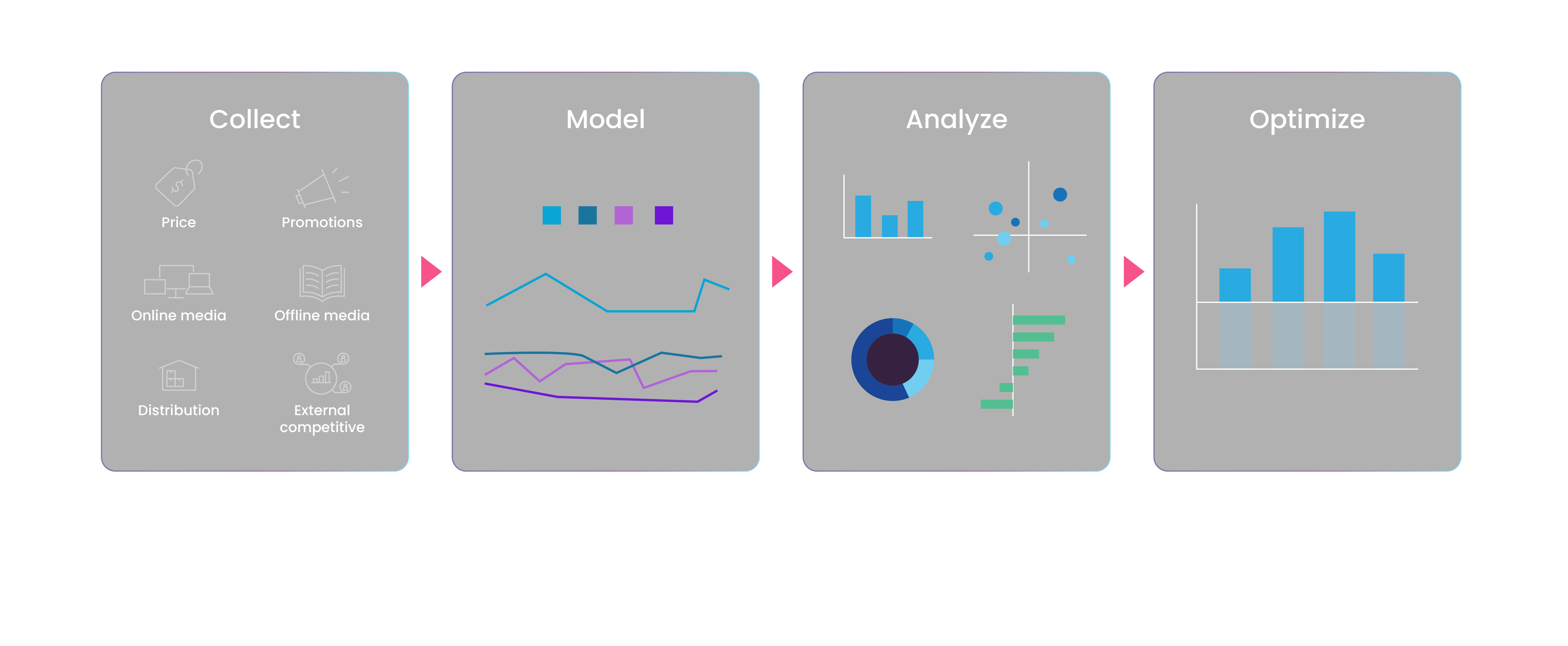As marketing professionals, we are constantly seeking ways to optimize our marketing efforts and maximize our return on investment. In today's data-driven world, one of the most powerful tools at our disposal is Market Mix Modelling (MMM). By analyzing the impact of various marketing activities on business performance, MMM provides invaluable insights for making informed decisions and achieving a holistic view of our marketing performance.

Nielsen points to 4 stages of the Market Mix Modelling process
At its core, Market Mix Modelling is a statistical analysis that quantifies the relationship between marketing inputs (such as advertising spend, promotions, pricing, and distribution) and a company's sales or other business metrics. By teasing out these relationships, MMM helps marketers understand the effectiveness of each marketing element and allocate resources strategically.
Unlocking the power of MMM
Market Mix Modelling offers several fascinating aspects that make it stand out as a valuable tool in the marketer's arsenal:
- Data-driven Decision Making: By analyzing historical data, MMM enables marketers to make informed decisions based on real-world results.This data-driven approach ensures a more accurate understanding of the impact of different marketing activities.
- Granularity and Precision: MMM allows marketers to drill down into specific marketing activities, such as individual campaigns or channels, to understand their contribution to overall business outcomes. This level of granularity provides actionable insights for optimizing marketing efforts at a more tactical level.
- Cross-Channel and Cross-Effect Analysis: MMM takes into account the interdependencies and interactions between different marketing elements. It helps marketers evaluate how changes in one area, such as increased advertising spend, can impact other areas, such as pricing or promotions. This holistic view allows for a more comprehensive understanding of the dynamics of the marketing mix.
- Forecasting and Planning: With the help of MMM, marketers can forecast the business impact of different marketing scenarios and plan their budgets and strategies accordingly. This forward-looking analysis empowers marketers to be proactive and agile in their decision-making processes.
Data integrity and live data: The bedrock of MMM
When it comes to Market Mix Modelling, the phrase "garbage in, garbage out" couldn't be more accurate. The quality and integrity of the data used for analysis play a crucial role in deriving meaningful insights. To achieve reliable results, it is imperative to ensure the following:
- Data Accuracy and Completeness: Accuracy and completeness of the data used for the analysis are vital for reliable results. This includes maintaining consistent data formats, resolving data discrepancies, and cleansing the data of any errors or outliers.
- Timeliness and Live Data Integration: Incorporating live data into the analysis allows marketers to have a real-time view of their marketing performance. By integrating data from various sources, such as sales data, media buying data, and website analytics, marketers can track and measure the impact of their marketing efforts as they unfold.
- Overcome Attribution Challenges: One of the key challenges in Market Mix Modelling is accurately attributing the impact of marketing activities in a complex ecosystem. This requires careful consideration of factors such as external influences (e.g., market conditions, competitor actions) and internal factors (e.g., product changes, seasonality) that may impact business outcomes.
Pros and Cons of MMM
While Market Mix Modelling offers numerous benefits, it is essential to compare it with other commonly used methods for a comprehensive understanding. Let's explore the advantages and disadvantages:
Pros:
- Provides a holistic view of marketing performance, helping marketers understand the relative contribution and effectiveness of different marketing elements.
- Enables data-driven decision-making and optimization of marketing budgets by identifying the most efficient marketing activities.
- Supports forecasting and scenario planning, allowing marketers to assess the marketing plan.
Cons:
MMM efficacy can be hampered by the complexity of some of the statistical modeling techniques and lack of in-house expertise, data limitations in terms of quality and accuracy, and time lag due to the reliance on historical data, which might not reflect the current marketing landscape. Data integrity, governance and lineage is thus a key to making this successful.
Critics who call MMM broken also refer to the gaps in the execution and analysis, which can be overcome with better measurement models.
- The flip side of attribution bias is overlooking channel synergies. Very often, experience tells us the multiplier effect of, say, mainstream plus digital. A truly integrated approach in the modeling can help measure the impact.
- Undervaluing long-term brand-building effects in favor of ROI of bottom-of-funnel marketing.
- Not measuring the value of ad messaging and content/creative in favor of just ad GRPs and channel spends.
Challenges that need to be kept in mind, though, while building out MMM models are -
- Requires a sufficient amount of historical data to produce meaningful results, making it challenging for new products or markets.
- Relies on statistical assumptions and modeling techniques, introducing a margin of error.
- Inherent challenges in accurately attributing the impact of marketing activities within a complex, multi-channel marketing ecosystem.
The Future of Market Mix Modelling
The future of MMM holds promising developments that will further enhance its effectiveness:
- Advanced Analytics and Artificial Intelligence: The integration of advanced analytics techniques, such as machine learning and predictive modeling, will enable more accurate and dynamic analysis. These technologies can help marketers uncover complex patterns and interactions within the marketing mix, leading to more precise insights. They do this by using complex ML algorithms which automatically take into account interaction effects, non-linear correlations, and also the time-delayed effect of media.
- Real-Time Data Integration: With the advancements in technology, the integration of live data into Marketing Mix Modelling will become more seamless. Real-time data will enhance decision-making capabilities and enable marketers to react promptly to changing market conditions.
- Cross-Platform Attribution: MMM will continue to evolve to address the challenges posed by the proliferation of digital channels and touchpoints. Insights into the cross-platform attribution of marketing activities will be vital for accurately measuring their impact.
Finally, the role of a good marketing analytics dashboard solution
To make the most of their market mix modeling exercise, marketers need to be able to use the insights effectively. Visualization and sharing of these insights,, monitoring performance and focusing on key metrics is essential to the modern marketing practice.
Many marketers use Arena Calibrate as a solution to producing and sharing of marketing insights.
Test drive Arena Calibrate for free and check out our pricing and plug & play BI customization services.




